
Texas A&M AgriLife Extension Service was formally established in 1915 after the 1914 passing of the Smith-Lever Act and in conjunction with Texas A&M University. Originally named Texas Agricultural Extension Service, then later Texas Cooperative Extension, the name Texas AgriLife Extension Service was adopted on January 1, 2008. A&M was added to the agency name on September 1, 2012 as a result of a Texas A&M University System change to strengthen the association with Texas A&M. The primary mission of AgriLife Extension is to provide educational outreach programs and services to the citizens of Texas. In conjunction with Texas A&M AgriLife Research, the Extension faculty members conduct research and bring practical applications of those research findings to the people of Texas.

The Cyrus McCormick Farm and Workshop is on the family farm of inventor Cyrus Hall McCormick known as Walnut Grove. Cyrus Hall McCormick improved and patented the mechanical reaper, which eventually led to the creation of the combine harvester. The farm is near Steele's Tavern and Raphine, close to the northern border of Rockbridge and Augusta counties in the U.S. state of Virginia, and is currently a museum run by the Virginia Agricultural Experimental Station of Virginia Tech. The museum has free admission and covers 5 acres (2.0 ha) of the initial 532-acre (215.3 ha) farm.
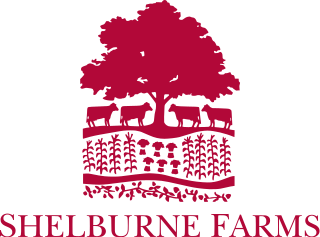
Shelburne Farms is a nonprofit education center for sustainability, 1,400 acres (570 ha) working farm, and National Historic Landmark on the shores of Lake Champlain in Shelburne, Vermont. The property is nationally significant as a well-preserved example of a Gilded Age "ornamental farm", developed in the late 19th century with architecture by Robert Henderson Robertson and landscaping by Frederick Law Olmsted.

The New Hampshire Farm Museum is a farm museum on White Mountain Highway in Milton, New Hampshire, United States. Three centuries of New Hampshire rural life are presented in the historic farmhouse. The museum includes a 104-foot-long (32 m) three-story great barn with collection of agricultural machinery, farm tools, sleighs and wagons. There are also live farm animals, a nature trail and a museum shop. The museum is located on the former Plumer-Jones Farm, a traditional series of connected buildings with farmhouse dating to the late 18th century and barns dating to the mid 19th century, which was listed on the National Register of Historic Places in 1979.

Fountain Lake Farm, also known as the Wisconsin Farm Home of John Muir, is a historic farm and National Historic Landmark in rural Montello, Wisconsin, United States. The landmark covers part of the farm that was the home of pioneering conservationist John Muir from 1849 to 1856 and 1860 to 1862. Covering 80 acres (32 ha), the landmarked area is partly private property and partly in John Muir Memorial County Park, a minimally developed public park.

Rokeby Museum is a historic farm property and museum at 4334 United States Route 7 in Ferrisburgh, Vermont. The 90-acre (36 ha) property includes a 1780s farmstead, and eight agricultural outbuildings with permanent exhibits. Hiking trails cover more than 50 acres (20 ha) of the grounds. Rokeby is open from mid-May to mid-October each year. The property was designated a National Historic Landmark in 1997 for its association with Rowland T. Robinson, a Quaker and ardent abolitionist who openly sheltered escaped slaves at Rokeby as part of the Underground Railroad. Robinson's extensive correspondence is an essential archive giving insight into the practices of abolitionists and the operations of the railroad.
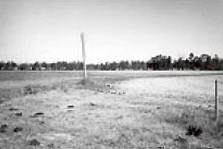
Coker Experimental Farms, also known as Coker Pedigreed Seed Company, is a National Historic Landmark agricultural site at 1257 South Fourth Street in Hartsville, South Carolina, USA. The property, which is now owned by a museum, was the location where David R. Coker conducted crucial breeding experiments to enhance the strains of cotton and other crops cultivated in the southern United States. Coker was a major force in the development of agricultural extension services in the South in the early decades of the 20th century. What remains of his farm was declared a National Historic Landmark in 1964.
The Bernhard Warkentin Homestead, also known as Little River Stock Farm or Warkentin Farm, is a historic farm complex on East North Street in Halstead, Kansas. It was listed on the National Register of Historic Places in 1974. It was further declared to be a National Historic Landmark in 1990, nationally significant for its association with Bernhard Warkentin, a pivotal figure in the development and wide cultivation of durum wheat in the country.

The Frawley Ranch is an historic ranch in Lawrence County, South Dakota, near Spearfish, South Dakota. Henry Frawley developed what became the largest and most successful cattle ranch in western South Dakota by purchasing lands that had failed as smaller homesteading parcels. The property was declared a National Historic Landmark in 1977.
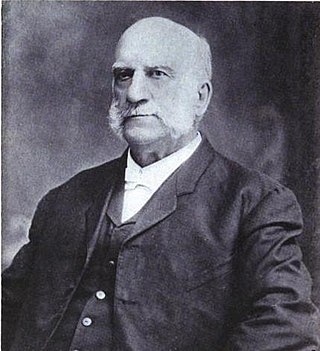
Seaman Asahel Knapp was a Union College graduate, Phi Beta Kappa member, physician, college instructor, and, later, administrator, who took up farming late in life, moving to Iowa to raise general crops and livestock.
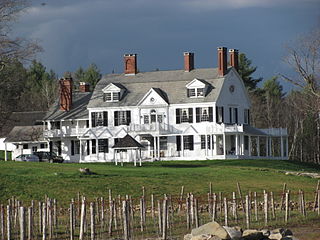
Brook Farm is a historic country estate farm at 4203 Twenty Mile Stream Road in Cavendish, Vermont. It includes one of the state's grandest Colonial Revival mansion houses, and surviving outbuildings of a model farm of the turn of the 20th century. It was listed on the National Register of Historic Places in 1993. The property is now home to the Brook Farm Vineyard.

This is a list of the National Register of Historic Places listings in Kaufman County, Texas.

This is a list of the National Register of Historic Places listings in Terrell County, Texas.

The George Washington Faulkner House, known also as Faulkner House and as Faulkner Farm, in Santa Paula, California, was built in 1894. The Queen Anne style house was a work of architect/builders Herman Anlauf and Franklin P. Ward.

The Raymond Rebarchek Colony Farm is a historic farm property on Rebarchek Avenue in Palmer, Alaska. It consists of a 40-acre (16 ha) tract of land granted to Raymond Rebarchek in a 1935 land lottery organized by the Matanuska Valley Colony, a Depression-era agricultural colony project. The property was listed on the National Register of Historic Places in 1978. At that time, the farm complex included ten buildings, including Rebarcheck's original log house, a dairy barn, a well house, a greenhouse, and a chicken house. Only the original farmhouse, silo, and milking parlor are still standing today. The Alaska State Fair purchased the property in 2002 and is contemplating the establishment of a demonstration farm there.

Top Acres Farm, known historically as the Fletcher–Fullerton Farm, is a farm property at 1390 Fletcher Schoolhouse Road in Woodstock, Vermont. Developed as a farm in the early 19th century, it was in continuous agricultural use by just two families for nearly two centuries. It was listed on the National Register of Historic Places in 2004.

Lee Farm is a historic farm property on Vermont Route 18 in Waterford, Vermont. Established in 1801, it was for many years worked by members of the Lee family, and part of a thriving rural community called Waterford Hollow. Its farmstead features surviving 19th and early 20th-century outbuildings and a high-quality Greek Revival farmhouse. A 5-acre (2.0 ha) portion of the farm, encompassing the farmstead, was listed on the National Register of Historic Places in 1983.

The Smith Ranch, in Johnson County, Texas near Rio Vista, Texas, and also known as Grand Valley Lands, was established in 1887. It was listed on the National Register of Historic Places in 2007.
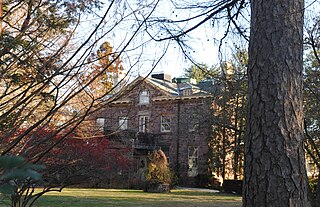
The Withington Estate, also known as the Heathcote Farm, is a 12.5-acre (5.1 ha) farmstead located on Spruce Lane near the Kingston section of South Brunswick in Middlesex County, New Jersey. The farm is adjacent to the Cook Natural Area and the Heathcote Brook. It was added to the National Register of Historic Places on September 27, 1984, for its significance in agriculture, architecture, landscape architecture and politics/government. In addition to the main residence, a stone barn and carriage house contribute to the property.

Fernbrook Farms is a 230-acre (93 ha) working farm located along County Route 545 in Chesterfield Township in Burlington County, New Jersey. Originally an 18th-century farm, it was briefly a stock breeding farm, known as the New Warlaby Stock Farm, in the 19th century. It now includes an inn, plant nursery, environmental education center, and community-supported agriculture. It was added to the National Register of Historic Places on July 7, 2022, for its significance in architecture and landscape architecture.
























